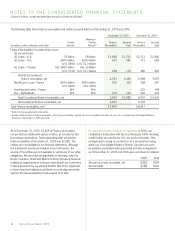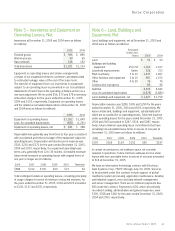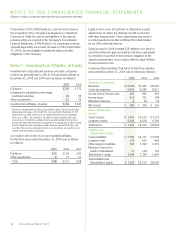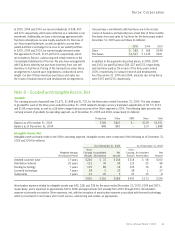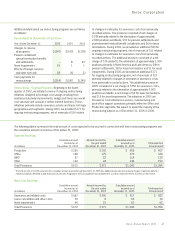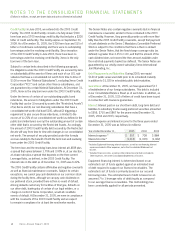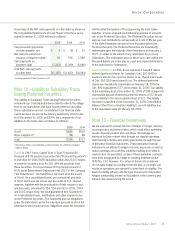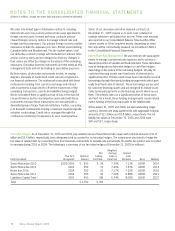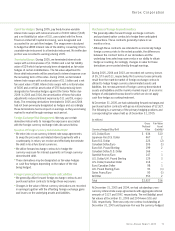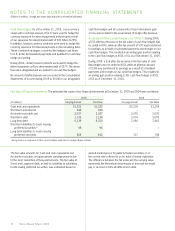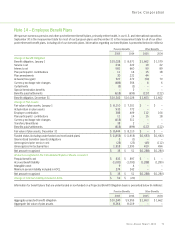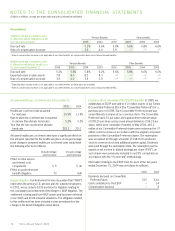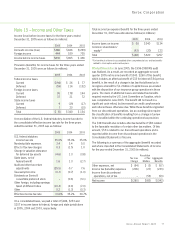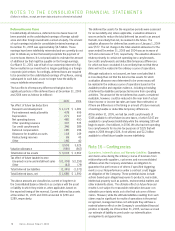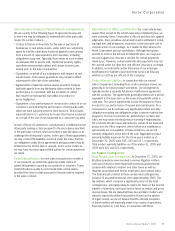Xerox 2005 Annual Report Download - page 78
Download and view the complete annual report
Please find page 78 of the 2005 Xerox annual report below. You can navigate through the pages in the report by either clicking on the pages listed below, or by using the keyword search tool below to find specific information within the annual report.
NOTES TO THE CONSOLIDATED FINANCIAL STATEMENTS
(Dollars in millions, except per-share data and unless otherwise indicated)
70
Weenter into limited types of derivative contracts, including
interest rate and cross-currency interest rate swap agreements,
foreign currency spot, forward and swap contracts and pur-
chased foreign currency options to manage interest rate and
foreign currency exposures. Our primary foreign currency market
exposures include the Japanese yen, Euro, British pound sterling,
Canadian dollar and Brazilian real. The fair market values of all
our derivative contracts change with fluctuations in interest rates
and/or currency rates and are designed so that any changes in
their values are offset by changes in the values of the underlying
exposures. Derivative financial instruments are held solely as risk
management tools and not for trading or speculative purposes.
By their nature, all derivative instruments involve, to varying
degrees, elements of market and credit risk not recognized in
our financial statements. The market risk associated with these
instruments resulting from currency exchange and interest
rate movements is expected to offset the market risk of the
underlying transactions, assets and liabilities being hedged.
Wedo not believe thereis significant risk of loss in the event of
non-performance by the counterparties associated with these
instruments because these transactions areexecuted with a
diversified group of major financial institutions. Further,our policy
is to deal with counterparties having a minimum investment-grade-
or-better credit rating. Credit risk is managed through the
continuous monitoring of exposures to such counterparties.
Fair Value Hedges: As of December 31, 2005 and 2004, pay variable/receive fixed-interest rate swaps with notional amounts of $1.8
billion and $2.4 billion, respectively,were designated and accounted for as fair-value hedges. The swaps were structured to hedge the
fair value of related debt by converting them from fixed-rate instruments to variable-rate instruments. No ineffective portion was recorded
to earnings during 2005 or 2004. The following is a summary of our fair value hedges at December 31, 2005 (in millions):
Weighted-
Net Average Interest
Year First Notional Liability Interest Rate
Debt Instrument Designated Amount Fair Value Rate Paid Received Basis Maturity
Senior Notes due 2010 2003/2005 $ 550 $ (9) 7.39% 7.13% LIBOR 2010
Senior Notes due 2013 2003 250 (3) 7.40% 7.63% LIBOR 2013
Notes due 2016 2004 250 (3) 7.17% 7.20% LIBOR 2016
Senior Notes due 2011 2004 250 (6) 7.26% 6.88% LIBOR 2011
Liability to Capital Trust I 2005 450 (18) 6.34% 8.00% LIBOR 2027
Total $1,750 $ (39)
Some of our derivative and other material contracts at
December 31, 2005 require us to post cash collateral or
maintain minimum cash balances in escrow. These cash amounts
are reported in our Consolidated Balance Sheets within Other
current assets or Other long-term assets, depending on when
the cash will be contractually released, as presented in Note 1
to the Consolidated Financial Statements.
Interest Rate Risk Management: We use interest rate swap agree-
ments to manage our interest rate exposure and to achieve a
desired proportion of variable and fixed-rate debt. These derivatives
may be designated as fair-value hedges or cash flow hedges,
depending on the nature of the risk being hedged. Virtually all
customer-financing assets earn fixed rates of interest and a
significant portion of those assets have been matched to secured
borrowings through third-party funding arrangements which gen-
erally bear fixed rates of interest. These borrowings are secured
by customer-financing assets and are designed to mature as we
collect principal payments on the financing assets which secure
them. The interest rates on a significant portion of those loans
are fixed. As a result, these funding arrangements create natural
match funding of the financing assets to the related debt.
At December 31, 2005 and 2004, we had outstanding single
currency interest rate swap agreements with aggregate notional
amounts of $2.1 billion and $2.8 billion, respectively.The net
liability fair values at December 31, 2005 and 2004 were
$40 and $37, respectively.
Xerox Annual Report 2005


